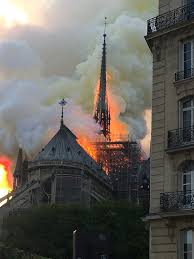The Fire of Notre Dame

April 28, 2019
If walls could talk, then what stories Notre-Dame de Paris could tell. She would speak of how, within her halls, Napoleon seized control of France, how in the sight of her rose window the Nazis marched into the City of Light, how on the soil upon which she rests the Romans sang their prayers to Jupiter, king of the gods. The waters that surround her little island knew a time before Paris or France; the thorns that she clutched to her chest knew a day before the Son of God threw aside the boulder of His tomb. Notre Dame was there when King Louis XVI was overthrown, when the Kaiser’s land was subjugated, when the people of her city refused to cower before the darkness. So, when the serpents of fire encircled her spire only four days before the memorial of the Crucifixion, the world rushed into action. And as the situation became dire, the people of Paris offered sacrifices of their own. The basilica whose beauty had captivated millions since the days when the Sistine Chapel’s ceilings were blank suddenly saw the face of the God she honored reflected as the tongues of fire danced above her rooftop, as people risked their own lives, to rescue this symbol and everything it stood for.
To recount the triumphs of that long night is to tell the newest chapter in the global history of Christianity and the arts. The salvation of the cathedral came from 400 firefighters, working for five hours to ultimately preserve the building’s structure and most of its art. Their chaplain, Jean-Marc Fournier, rushed into the fire and formed a chain of men with the brigade to escort the legendary crown of thorns to safety. This same priest served as a chaplain to troops in Afghanistan and was tending to the hurt and dying after the attacks on Paris in 2015. A massive crowd surrounded Notre Dame singing ‘Ave Maria,’ showcasing faith in the divine as a force that defies people’s supposed differences to unite them in the act of love for the common good. The morning after the blaze, the cathedral’s cross glowed in the rubble — a striking and powerful image for the promise of Christianity and the events of Easter in the new millennium, a reminder that God did not design humanity or the world to be perfect but for us to learn from our own errors and rebuild from the ashes.
For those who have been seeking signs of light and hope in the realm of religion, it is moments like this, that provide the feeling of security and gratitude that religion can offer. In fact, there is perhaps one image from the Notre Dame catastrophe that best exemplifies the whole matter: in the wreckage, after the collapse of the spire, there was a copper rooster that had stood upon the top of the spire for centuries. Within that rooster were two items from French saints and a thorn from Christ’s crown. Is the rooster an unlikely symbol of victory in the face of the seemingly unstoppable wrath of nature? Maybe.
And even still, it is somehow fitting that this seemingly silly metal bird is now the subject of a possible miracle, and that even as Notre Dame appeared to be dying, a new piece of history was born that, hopefully, will inspire future generations and make them proud to share the experience of stepping
within her walls.
